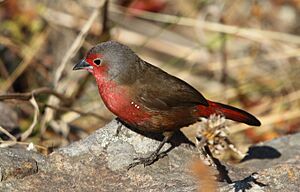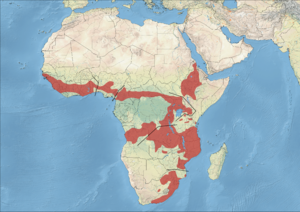African firefinch facts for kids
Quick facts for kids African firefinch |
|
|---|---|
 |
|
| Male, KwaZulu-Natal | |
| Conservation status | |
| Scientific classification | |
 |
|
| The distribution of the African firefinch |
The African firefinch (Lagonosticta rubricata) is a small, colorful bird found across many parts of Africa. It's also known as the blue-billed firefinch because of its beak color. This common bird belongs to a group called estrildid finches. It lives in a very large area, covering about 5.4 million square kilometers (over 2 million square miles)!
Contents
About the African Firefinch's Name
The African firefinch got its official scientific name in 1823 from a German scientist named Hinrich Lichtenstein. He first called it Fringilla rubricata. The word rubricata comes from Latin and means "orange-red" or "ruddy," which describes the bird's bright colors. Later, it was moved to a different group of birds called Lagonosticta.
There are five slightly different types, or subspecies, of the African firefinch. These types live in different parts of Africa. For example, one type lives from Senegal to Nigeria, while another is found in South Africa. They mostly look similar but might have small differences, like the color of their bill.
What Does the African Firefinch Look Like?
The African firefinch is a small bird, usually red and brown. Males have a lead-grey head and neck, with olive-brown wings. Their lower back and outer tail feathers are a deep carmine red, while the rest of their tail is black.
The male's chest and belly are a bright scarlet red. You might see small white spots on its upper chest and sides. The center of its belly is grey, turning black near its tail. Its short, pointed beak is blackish-grey with a pink base on the lower part.
Female African firefinches look similar to males but are not as brightly colored. Young birds don't have any red on their undersides. These birds are about 10 to 11 centimeters (4 to 4.3 inches) long. They weigh between 8.6 and 11.7 grams (about 0.3 to 0.4 ounces).
What Does the African Firefinch Sound Like?
Both male and female African firefinches sing. Their song includes various ringing notes that are repeated, mixed with squeaky whistles and trills. When they sense danger, they make a harsh ticking sound. Other common calls include a rising trilling twitter, like "trrrrrrrr-t," and a loud, clear "tui-tui-tui-tui," often followed by "wink-wink-wink."
Where Do African Firefinches Live?
African firefinches live in different areas across Africa, south of the Sahara Desert. You can find them from Senegal in the west, all the way east to Ethiopia. They also live south through countries like Tanzania and Mozambique, down to the Eastern Cape province of South Africa.
These birds usually prefer places that are humid and have lots of thick plants. They like forest edges, savannas with acacia trees, and areas with tall grass or thorny bushes. You can often spot them along streams and rivers where there's thick plant life, especially near quiet paths. Sometimes, they visit gardens and villages, but they are not as common there as some other firefinch species.
How Do African Firefinches Behave?
What Do African Firefinches Eat?
African firefinches mainly eat seeds. They also eat insects to add to their diet. They usually look for food on the ground, searching through the soil. These birds are often seen in pairs or small family groups. They might even join other firefinch species. They like to stay close to bushes or trees so they can quickly hide if they feel scared.
How Do African Firefinches Raise Their Young?
The male African firefinch builds the nest. It's a round nest with an opening on the side. The outside is made of long, dry grass blades, and the inside is lined with soft grass flowers, sometimes even feathers. The nest is usually hidden deep in tall, thick grass, under bushes, or among fallen branches.
Female firefinches lay 2 to 5 eggs. In southern Africa, they lay eggs from November to June, with most eggs laid between January and April. Both parents take turns sitting on the eggs, which hatch in about 12 days. Once the chicks hatch, both parents feed them for 2 to 3 weeks until they are ready to fly. After leaving the nest, the parents continue to feed them for about 10 more days until the young birds can find food on their own. Interestingly, another bird called the dusky indigobird sometimes lays its eggs in the African firefinch's nest, letting the firefinch raise its chicks.




